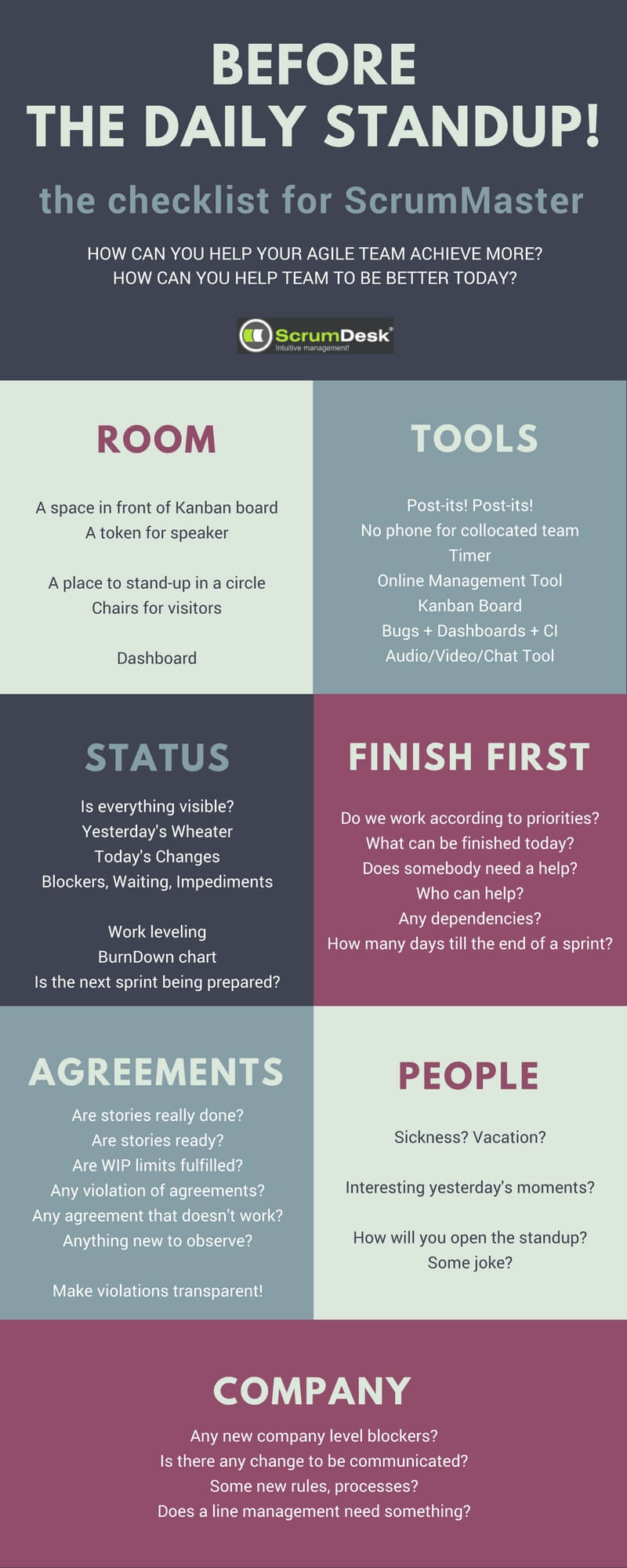The daily standup meeting is a fundamental ceremony in Scrum. Even if you do not follow Scrum, it has a huge impact due to the transparency it brings.
Most of the Agile teams and ScrumMasters think the daily standup ceremony is the easiest part of Scrum. Well, should it brings you the value, you want to do it correctly. In a disciplined way.
Agile is about freedom & responsibility. You need a disciplinne to be successful in Agile!
We observed 100+ agile teams and found out following tips as important for the success of the Agile team. Do not expect a daily standup template. Our aim is to show you what it should be considered, however, do not forget that Agile is about adoption.
The Room
The Kanban board is the place where synchronization happens. Here the team talks about goals they want to achieve in the sprint and about blockers slowing them down. All team members should be able to stand in front of the Kanban board. Therefore, a space in front of the Kanban board is necessary.
Team members should see everybody else eyes to eyes.
Therefore the best is to stand up in a circle.
The standup is not just for the team. Anybody from the company should be able to attend it, ideally. They need to have chairs. Such people should be, however, silent in the standup. They are there to understand the progress of the team. If they need to speak, they should ask ScrumMaster to call them during the standup. In most cases, it is at the end of the daily meeting.
The rules are simple. Who stands speaks. Who sits should be silent.
Chairs are for guests.
In the standup, people used to stand at the same place every day. After a few minutes, people tend to lose concentration. They usually wait for the nearest colleague to start speaking. If you observe the loss of concentration, try to use a token for the speaker.
The best is a plushie, it is easy to catch for people.
Do you use an electronic project management tool? Maybe you will need to see some dashboards to see the status of continuous integration, errors from the production, performance indicators, etc.
Tools
Post-its! Post-its! Why? The team will identify new subtasks they forgot. New requirements will arrive at the team’s board. There will be blockers and you will want to track their status.
Do not bring phones to your dailies. If you do stand up in your team’s room, do not forget to switch off your desk phones.
In the first few dailies, it will be very helpful to indicate to the team how long they do speak. This way team will build up the habit and feeling of 15 minutes.
We used to suggest using a tablet or Agile ToolboX to indicate remaining time to the team.
If you do not use a physical Kanban board, display an electronic kanban board from your Scrum online management tool.
Have visual reference for better coordination of the team.
Is your team distributed? Test audio/video/chat tool before the standup. ScrumMasters, come 10 minutes earlier and open the channel so the team can test the connection before the standup.
Do not forget to prepare a bugs tracking system and additional dashboards if the team needs them.
Status
Is really everything visible? All the work should be pinned to the Kanban board. There should be no work in emails, excel files, or other task management tools.
ScrumMaster should check Yesterday’s Weather, the changes since the last standup, so he can guide the team to pull the best-fit tasks. Read the Kanban board carefully.
What has been done, what should be done, what should be started, what takes longer than estimated, what is a blocker, where blockers were removed already, which tasks are waiting for somebody?
Are you aware of today’s changes that the team should be informed about? Check them before the daily standup!.
Blockers, Waiting, Impediments. You are the master of them. Control them, help remove them. That’s your duty. Listen to the team if they do not mention something new, missing, on the board.
Do not forget to check the burndown chart. Try to understand it. Check also how work is distributed, check work leveling. Sometimes the team needs to identify who can help. You will be ready then!
What is next?
We will explain Finish First, Agreements, People and Company parts of the checklist.
- Who is Scrum Master?
- The Product Owner and Scrum Master Responsibilities
- Training Agile and Scrum Fundamentals
- Training Great Scrum Mastership
- Training SAFe Scrum Master
- Training SAFe Advanced Scrum Master
- Training SAFe Release Train Engineer
- Book Scrum and XP from Trenches by Henrik Kniberg, Slovak translation

